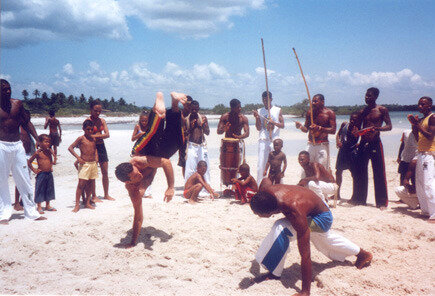Rugendas, 1835 "Jogar Capoëra - Danse de la guerre"
History of Capoeira
Capoeira evolved in colonial Brazil as a fusion of martial arts and West African music and dance. During the Atlantic slave trade of the 16th to 19th centuries, European traders shipped millions of slaves from western Africa to the Americas. Brazil was the most common destination for African captives with 42% of all enslaved peoples shipped across the Atlantic. African slaves brought their culture and traditions with them, including food, stories, religion, music, and dance.
There are different theories on capoeira’s origins: Some say capoeira already existed in Africa as a courtship dance in Angola. Others think it was created in Brazil by the African slaves. We do know that capoeira was practiced by slaves in Brazil in sugarcane and coffee plantations and was disguised as a dance in order to appease the masters who recognized that capoeira would be a threat to their power and control on the African slaves.
Despite the terrible punishments imposed to all of those who rebelled against slavery, escaping was a constant practice. Runaways formed entire communities in the jungle called quilombos and there too, practiced capoeira. One of the most well known quilombos was called Quilombo dos Palmares and this where the famous leader Zumbi led the free Africans in defense against colonial forces.
After slavery was abolished in 1888, the freed people moved to the cities of Brazil and with no employment to be found, many joined or formed criminal gangs. They continued to practice capoeira, and it became associated with anti-government and criminal activities. As a result, capoeira was outlawed in Brazil in 1890. The punishment was extreme but capoeira continued to be practiced underground. Capoeira practitioners (capoeiristas) also adopted apelidos or nicknames to make it more difficult for police to discover their true identities. To this day, when a person is welcomed into capoeira at the batizado ceremony, they may be given an apelido. The law that prohibited the practice of capoeira was still effect until 1920, and its practice disguised as a folk dance. In hidden places capoeiristas did their best to keep the tradition alive.
Manoel Dos Reis Machado—Mestre Bimba
Mestre Bimba 1900-1974
In 1936, Mestre Bimba (1900-1974), one of the most influential masters of capoeira to this day, received an invitation from the president of Brazil to demonstrate his art in the capital. After a successful performance he went back to his home state of Bahia and with the government’s permission, opened the first capoeira academy. It was the first step towards a more open development, and years later the senate passed a bill establishing capoeira as a national sport. One of Mestre Bimba's students is Mestre Acordeon, a pioneer in bringing capoeira to North America. Today, capoeira is practiced all over the world including under Mestre Acordeon in Berkeley, California, and his student Mestre Galego in Sacramento.

Roda including Professor Galego (center left) in Bahia, Brazil 12/25/2001


